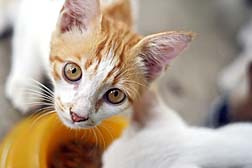 Melamine contamination in wheat gluten imported from China lay at the heart of the biggest pet food recall in recent history. What made it so big was the fact that Menu Foods, based in Canada, serves as the packager for dozens upon dozens of brands. It may say IAMS on the label, for example, and you may fancy that freshly-scrubbed workers in white coats are painstakingly packing your precious poodle's dinner into a designer can - but what you're actually buying are animal by-products manufactured at the sprawling Menu Foods facility in Streetsvile, Ontario.
Melamine contamination in wheat gluten imported from China lay at the heart of the biggest pet food recall in recent history. What made it so big was the fact that Menu Foods, based in Canada, serves as the packager for dozens upon dozens of brands. It may say IAMS on the label, for example, and you may fancy that freshly-scrubbed workers in white coats are painstakingly packing your precious poodle's dinner into a designer can - but what you're actually buying are animal by-products manufactured at the sprawling Menu Foods facility in Streetsvile, Ontario.In fact, the expensive stuff isn't a whole lot different from the cheap stuff.
According to the Animal Protection Institute (API), Menu Foods began immediate tests with their own lab animals and were horrified to witness dogs and cats turning horribly sick and dying from renal failure just a few days after ingesting the compromised food. The U.S. Food and Drug Administration (FDA) has received more than 17,000 reports of sick pets, 20 per cent of which did not survive. In Chicago, [Wendy Mena's Chihuahua puppy] died after eating Eukaneba. The API reports that more cats were affected than dogs.
Publicity over the recall, combined with the reality of treasured pets becoming sick from contaminated food, are prompting lawsuits such as the class action suit filed last month by a woman living in Cape Breton, Nova Scotia. Jackie Doucette remains concerned over her four-year-old collie Sissy, after the dog fell ill in late February and early March. Noticeably lethargic, the dog eventually collapsed into a stairwell and required extensive treatment to recover.
Beyond the melamine contamination, which most believe was an act of fraud by a Chinese supplier attempting to boost the perceived level of protein in wheat gluten, the Menu Foods recall has re-opened debate as to just what is in the pet foods we are feeding to our pets.
It should come as no surprise that unmentionable animal parts, the leftovers from the slaughterhouses, are a key ingredient in most of the pet foods manufactured today. Even so-called high-end foods that profess to use quality ingredients start off with things that would gag most people at the dinner table.
It's kind of like the folklore over what goes into a beef wiener (or chicken, for that matter). You may not want to know.
Most 'wet' pet foods (as opposed to the dry, crunchy pet food that is bulk-packed in large bags) use unmentionable by-products surplussed from the animal after it has been mined for human consumption. Premium brands of wet pet food and organics are made from better-quality scraps and as a rule do not use the lower-quality by-products.
The Menu Foods recall was confined to wet pet foods.
Most dry pet foods are a different animal altogether, in that they are manufactured using the rendering process. In other words, the 'raw materials' (to put it politely) are dumped into a huge vat and boiled for several hours to extract the oils and remove water. The high temperatures also kill bacteria, viruses and parasites. Unfortunately, the rendering process also robs the pet food-to-be of vital nutrients. They'll be added later.
The end result, after fiber is added in, is a kind of paste that is dried, cut up into pieces and sprayed with fat to make it 'tastier' for your pet.
In response to persistent rumours about the use of dog and feline carcasses as a raw ingredient for dry pet foods, the FDA conducted tests to check for the presence of pentobarbital, the most common drug used for euthanasia, in pet foods.
They found it.
What they didn't find however was any evidence of canine or feline DNA. Given that testing procedures used to test for DNA are extremely sensitive, it is unlikely that any DNA actually present might have been missed, and combined with findings of pentobarbital, overall the tests for dogs and cats, anyway, were inconclusive. That said, pentobarbital used to extinguish a diseased farm animal will often survive the extreme heat of the rendering process, only to show up in your dog's feeding dish.
According to the API, industry insiders admit that at one time rendered pets and road kill WERE used in the production of pet food, but that is no longer the case. However, there are no laws against it, and only recently were dead, dying, diseased or disabled animals banned for human consumption.
However, according to the API there is no such ban for pet foods.
READ MORE LEGAL NEWS
The Animal Protection Institute also raises the concern that bacterial endotoxins and ecoli from the carcasses of diseased animals, or deadstock left too long on the farm before delivery to the rendering plant, may survive the rendering process and wind up passed along in pet food.The Menu Foods recall was confined to contaminated wheat gluten from an unscrupulous manufacturer in China, and most reports of pets having died presented symptoms that suggested renal failure from melamine poisoning.
However, most pet foods are manufactured at approved levels that are far, far below the standard for human consumption.
If pets are like people - and if they were able to speak for themselves - they'd have a beef or two with the industry that feeds them.




